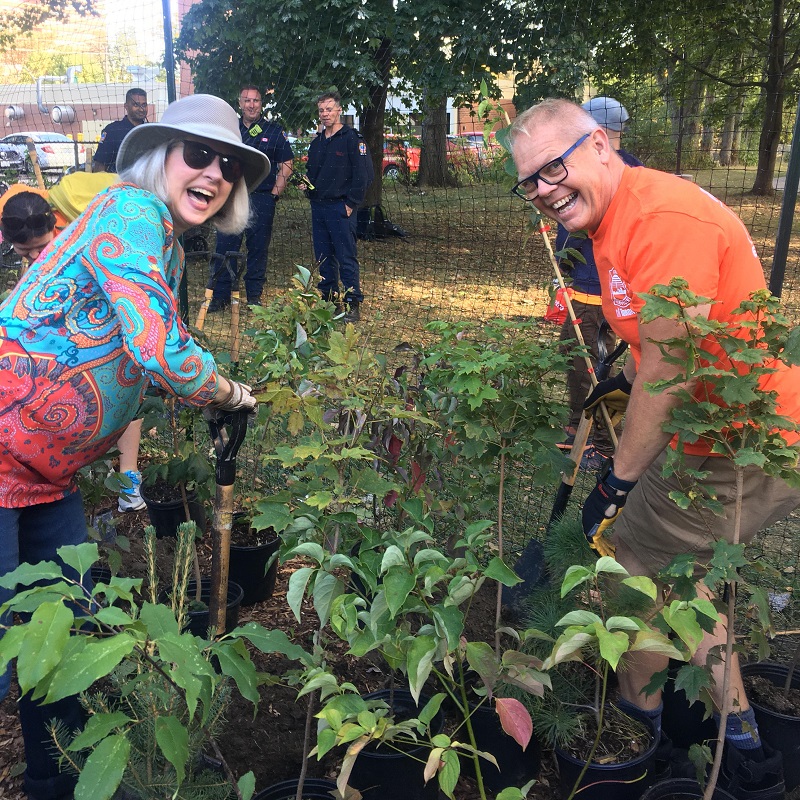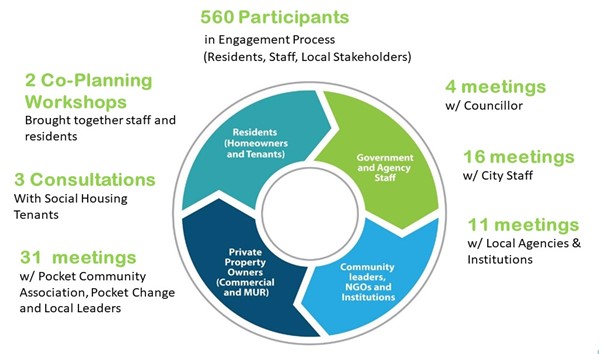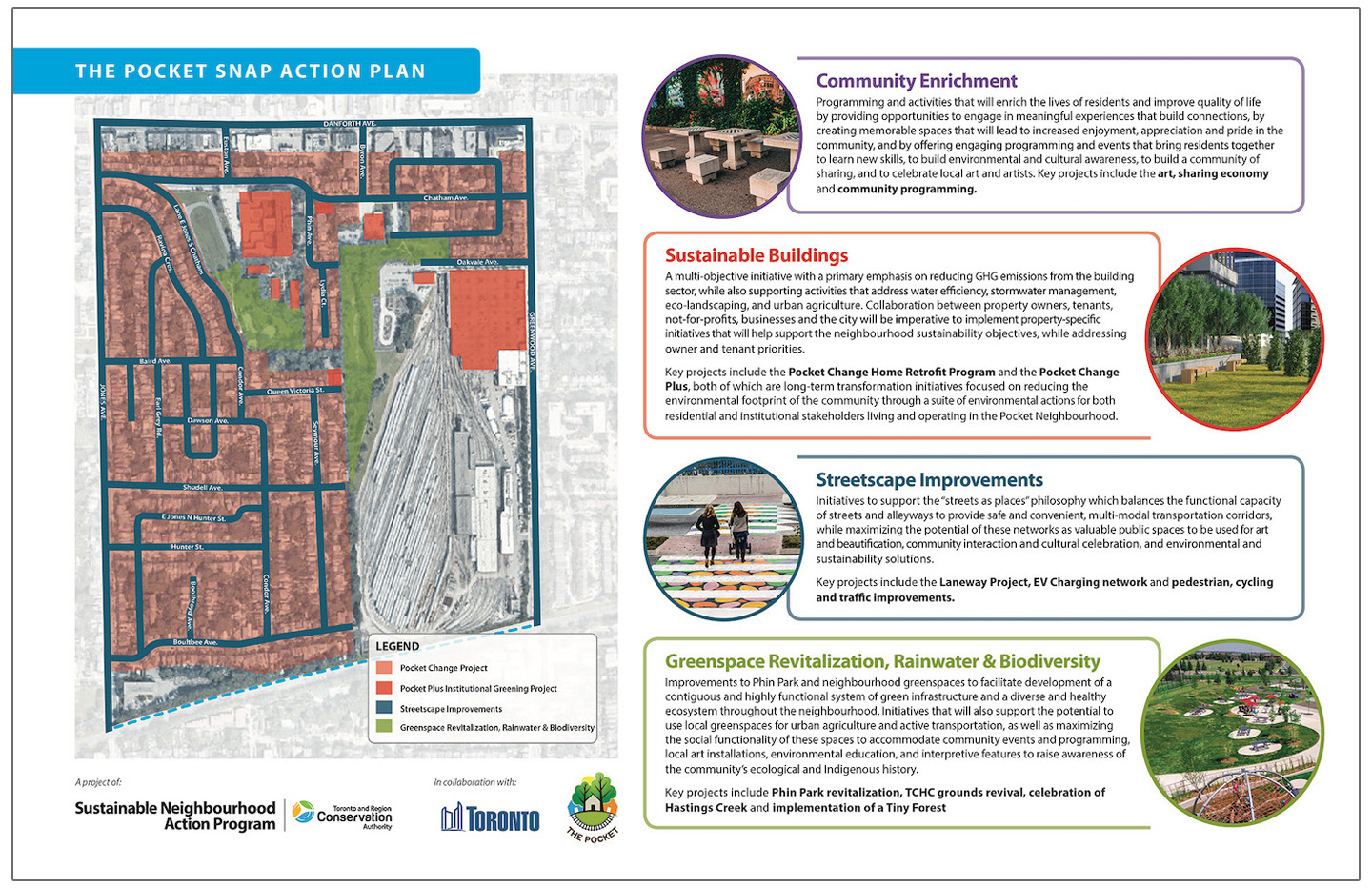Spring 2024 Native Tree and Shrub Giveaway

Are you interested in greening your property? The Pocket SNAP program has free trees and shrubs* available to interested homeowners and property owners living within the neighbourhood boundaries. (To confirm that you are in an eligible location, please refer to the boundary map.)
To submit orders, interested homeowners/property owners must complete the online form by Friday, April 5, 2024.
For more information, please contact hally.charendoff@trca.ca.
*Types of trees and shrubs are listed in the request form. Quantities are limited, and available on a first come, first-served basis.
Funded by the City of Toronto’s Urban Forestry Grants and Incentives Program.
About the Pocket SNAP
Toronto and Region Conservation Authority (TRCA) and the City of Toronto are working closely with neighbourhood community leaders, residents, and organizations to implement a Sustainable Neighbourhood Action Plan for the Pocket.
The Pocket SNAP was initiated and developed using a highly collaborative approach to foster co-design and co-ownership of the Action Plan among key stakeholders and the community.
Study Area Boundaries
Located in the east end of the City of Toronto, The Pocket neighbourhood is bounded by Danforth Avenue in the north, Jones Avenue and Greenwood Ave on the west and east sides respectively, and the CN Rail corridor at the south end.

Neighbourhood Selection & Key Drivers
The Pocket neighbourhood was selected based on a screening process led by TRCA, in collaboration with a team of 10 City of Toronto Divisions.
The screening process assessed the capacity and readiness of the community and identified key characteristics within the neighbourhood that aligned with the City of Toronto and TRCA’s urban renewal priorities.
The neighbourhood selection team identified the Pocket as a suitable pilot community because it has an active and enthusiastic community association with strong leadership, committed working groups, demonstrated ability to organize and implement projects and programming, and a strong track record of community advocacy.



Additionally, the community association has already identified and begun working on several key sustainability initiatives that TRCA could contribute to and help advance.
Learn more about the Pocket Community Association (PCA) and its Pocket Change Project:
Key technical drivers that informed neighbourhood selection include:
Greenhouse Gas Emissions (GHG)
With a mostly un-renovated building stock, developed in 1910-1915, the neighbourhood offers significant potential to reduce GHGs from residential and institutional buildings.
There is a large demographic of environmentally focused homeowners, which presents an opportunity to try revolutionary approaches to achieve ambitious GHG reduction targets.
Suitable Conditions for Low Impact Development (LID)
The neighbourhood soil permeability and depth to groundwater offer suitable conditions to manage stormwater on-site through LID approaches on public and privately-owned land.
Implementing LID in technically suitable areas across the city to infiltrate and retain rainwater supports Lake Ontario’s health and helps to prepare for the impacts of increased rainfall anticipated from climate change.
It is expected that the maximum daily rainfall in Toronto will be 166 millimeters in 2040, compared to 66 millimeters in 2009.
Limited Open Space and Urban Forest
The neighbourhood has a low rate of green space per capita, compared to the rest of the city, and a medium-low urban forest cover.
The neighbourhood offers an opportunity to demonstrate innovative approaches to achieve open space, habitat, and urban forest goals within limited available space.
Heat Stress
According to the City of Toronto’s ground surface temperature mapping, some areas of the neighbourhood are impacted by heat stress, which will be exacerbated with climate change.
According to Toronto’s Future Weather and Climate Driver study (SENES, 2011), Toronto temperatures are expected to rise by 5°C by the end of the century, leading to more variable extreme weather. It is anticipated that by 2040 the maximum daily temperature will be 44°C (compared to 37°C in 2009).
In 2040, the city will experience an estimated 66 days a year of temperatures above 30°C (compared to 20 days in 2009), and the number of extended heat waves in the year is expected to quadruple those experienced in 2009.
The SNAP Action Planning Process
The SNAP planning process brings together community members with technical staff for the co-creation of an Action Plan with shared outcomes, including measurable environmental improvements and climate adaptation strategies, as well as community health and well-being benefits.
The three-phase approach has been well tested and proven through previous SNAP projects.
Action Plan Co-Development Process
| PHASE 1: Builds baseline understanding of the neighbourhood context through rigorous technical analyses. In this phase, climate trends and associated local risks are also studied. |
| PHASE 2: The community’s motivational themes are identified, and high-level Action Areas are developed, using guiding principles and a framework of sustainability objectives and indicators to measure success. In Phase 2, a vulnerability assessment is also conducted, which introduces local knowledge of climate risks, assets, and adaptive capacity, gathered through the engagement process. |
| PHASE 3: The final Action Plan is co-developed. Integrated projects and programs are identified under each Action Area and an impact evaluation is conducted for the climate adaptation measures. During this phase, partnerships and resources are also identified to facilitate implementation. |
Meaningful community and stakeholder engagement is central to the action plan co-development process, for the purpose of achieving the following objectives:
- Understanding local top-of-mind themes and motivating interests
- Applying local knowledge on climate risks and assets/resources in the community
- Identifying shared plan objectives, projects, and recommendations
- Inviting involvement in early on-the-ground projects and build longer term relationships
- Facilitating capacity building to help support the action plan implementation
Engagement Summary
The Pocket Community Association has conducted extensive engagement over the years, creating a community that is highly receptive to the SNAP objectives. The PCA provided integral support throughout the action planning process, collaborating with the SNAP team to identify ongoing priorities throughout the implementation process.
Health restrictions related to the COVID-19 pandemic dictated the need for the majority of community engagement to take place in virtual and/or distanced events. Despite these restrictions, all engagement activities were well attended with substantial participation from the community.
The Pocket SNAP Action Plan
Download the Action Plan Report
The Pocket Sustainable Neighbourhood Action Plan (SNAP) is a comprehensive plan for neighbourhood revitalization and climate action that integrates local community interests, sustainability objectives, and climate adaptation strategies under the overarching theme of “a pocket of connection – green, serene, and working to become a net-zero neighbourhood”.
Local Sustainability Themes
The Action Plan comprises five sustainability themes. These themes have and will continue to inform the design of specific projects and initiatives, with each project/initiative striving to integrate as many themes as possible.
These themes were identified through robust community engagement and reflect the ecological values of the neighbourhood.
The five sustainability themes of the Pocket SNAP are as follows:
1. Ecological Health
Improving habitat and the connectivity of greenspaces, managing stormwater sustainability, enhancing and developing green streets and paths that connect the community, augmenting park infrastructure, and increasing accessible greenspace that integrates human enjoyment and nature needs.
2. Environmental Consciousness
Support home and building retrofits, support renewal and district energy, develop accessible/communal EV charging, manage waste sustainably, develop opportunities for gardening, permaculture, food production, and sharing, and develop and encourage sustainable transportation options including bike lanes, walkability, and transit use.
3. Social Consciousness
Support community connections (neighbourly spirit, local artists shops and restaurants), equity and inclusion (of all ages and abilities, cultural and religious, Truth and Reconciliation), the spirit of sharing (local services, resources, expertise, spaces, food, etc.), and community events and gatherings (community-building events such as eco fairs, street sales, parades and neighbourhood-wide parties).
4. Unique Character of the Pocket
Maintain the “Pocket feel” (green and serene, an escape from the busy-ness of life), support the Pocket’s sense of community togetherness, maintain safe and quiet streets (no “through” streets), and enhance and celebrate Hastings Creek.
5. Arts and Culture
Implement more public art/murals, support local and Indigenous artists, and use local, public art to tell a story (history of the Pocket, natural features, Truth and Reconciliation).
The Pocket SNAP Action Plan Map
Select the image below to view the full-sized map.
Action Areas & Implementation Projects
The Action Plan is organized around four key Action Areas. For each, several emerging signature projects and opportunities have been identified, based on technical priorities, community and stakeholder needs and dreams, and timing associated with previously planned capital projects or initiatives.
These initiatives are multi-objective and integrated, aiming to achieve the five local sustainability themes and guiding principles:
The Action Areas
1. Greenspace Revitalization, Rainwater, and Biodiversity
Improvements to Phin Park and neighbourhood greenspaces to facilitate development of a contiguous and highly functional system of green infrastructure and a diverse and healthy ecosystem throughout the neighbourhood.
Initiatives that will also support the potential to use local greenspaces for urban agriculture and active transportation, as well as maximizing the social functionality of these spaces to accommodate community events and programming, local art installations, environmental education, and interpretive features to raise awareness of the community’s ecological and Indigenous history.
Key projects include Phin Park revitalization, TCHC grounds revival, celebration of Hastings Creek and implementation of a tiny forest.
Implementation Progress to Date
- Neighbourhood-Wide Green Infrastructure (GI) Plan: A draft plan has been completed which brings together short and medium-term GI opportunities identified by the community; high priority areas for Low Impact Development (LID) for stormwater management; a tree planting opportunity analysis in all land uses; and heat stress areas that could benefit with GI.
- Habitat and Biodiversity Enhancement in Phin Park: In the spring of 2023, the existing pollinator garden was enhanced and a shade garden was created.
- Enhancement of Urban Agriculture in Toronto Community Housing (TCHC): At the request of residents, in the spring of 2023 TRCA delivered three raised planter beds and bulk soil to 2 Phin Avenue to expand the community garden and improve accessibility. Edible shrubs were also planted along the fence line.
- Implementation of a Tiny Forest in Oakvale Greenspace: This signature project entails the implementation of a tiny forest in a small area of 100 square meters in the TTC Oakvale Green Space. Tiny forests are densely planted arrangements of native trees and shrubs that quickly evolve into ecologically rich and biodiverse ecosystems. The concept of tiny forests was introduced by Japanese botanist Dr. Akira Miyawaki as an innovative approach to the reforestation of underutilized urban spaces. On September 30, 2023, the Pocket SNAP alongside 50-plus community volunteers planted the Pocket Tiny Forest with 300 native trees and shrubs. These species will help sequester carbon, manage stormwater, mitigate the urban heat island effect, and create wildlife habitat. Tiny forests also provide social benefits such as improved mental and physical health and deepened connections to nature. The project was developed in partnership with the City of Toronto, the Pocket Community Association (PCA), and the Network of Nature’s National Mini-Forest Pilot Program, with core funding from Green Communities Canada, Natural Resources Canada’s 2 Billion Trees Program, and TD Ready Commitment.
- Installation of Educational Signage: Five interpretive signs explaining the functioning and benefits of green infrastructure will be installed in five locations in Phin Park and Oakvale Greenspace. TRCA’s marketing team is currently designing the signs to be installed by City staff.
- Spring into Native Plants Program: TRCA delivered a Spring into Native Plants program over the March break of 2023. This is an interactive educational outdoor program about native plants and how to attract birds and butterflies to backyards or balcony/ container gardens.
- In addition, TRCA received funding from the City of Toronto’s Community Planting and Stewardship Grant to plant native trees and shrubs on private property (outside of the right of way). TRCA, in partnership with PCA, has been actively recruiting and educating homeowners for this initiative. In the spring of 2023, 50 trees and shrubs were distributed. A new list is being created for another delivery in the fall of 2023.



2. Sustainable Buildings
A multi-objective initiative with a primary emphasis on reducing GHG emissions from the building sector, while also supporting activities that address water efficiency, stormwater management, eco-landscaping, and urban agriculture.
Collaboration between property owners, tenants, not-for-profits, businesses and the City will be imperative to implement property-specific initiatives that will help support the neighbourhood sustainability objectives, while addressing owner and tenant priorities.
Key projects include the Pocket Change Home Retrofit Program and the Pocket Change Plus, both of which are long-term transformation initiatives focused on reducing the environmental footprint of the community through a suite of environmental actions for both residential and institutional stakeholders living and operating in the Pocket Neighbourhood.
Implementation Progress to Date
- Two case studies were developed on homes within the Pocket neighbourhood on the impact of Air Source Heat Pumps (ASHPs). Follow these links to see the results:
- Hybrid Heating in a Toronto Century Home
- Hybrid Heating in a Semi-Detached House
- Both case studies were featured in this Corporate Knights article
- A workshop on ASHPs was delivered to Pocket homeowners. WATCH NOW.
- A Pocket homeowner shared their experience with ASHPs. WATCH NOW.
3. Streetscape Improvements
Initiatives to support the “streets as places” philosophy which balances the functional capacity of streets and alleyways to provide safe and convenient, multi-modal transportation corridors, while maximizing the potential of these networks as valuable public spaces to be used for art and beautification, community interaction and cultural celebration, and environmental and sustainability solutions.
Key projects include the Laneway Project, EV Charging network and pedestrian, cycling and traffic improvements.
Implementation Progress to Date
- The City of Toronto’s Transportation Services Division has been working with TRCA and the community to explore potential timelines, resources, and technical needs to advance streetscape improvements recommended in the Action Plan, including resident informed pedestrian improvements, green streets, electric vehicle charging stations, public art, and the transformation of the E Jones / S Chatham Laneway.
4. Community Enrichment
Programming and activities that will enrich the lives of residents and improve quality of life by providing opportunities to engage in meaningful experiences that build connections, by creating memorable spaces that will lead to increased enjoyment, appreciation and pride in the community, and by offering engaging programming and events that bring residents together to learn new skills, to build environmental and cultural awareness, to build a community of sharing, and to celebrate local art and artists.
Key projects include public art, sharing economy and community programming.
- Refer to Action Area One for list of overlapping implementation projects that address Action Area Four and Action Area One simultaneously.
- Phin Park Community Planting Event and Pollinator Education: A community planting event was hosted by TRCA on June 25, 2023 with support from the PCA.
- Tiny Forest Community Planting Event: TRCA hosted a community planting event to implement the tiny forest project on September 30, 2023.
- Community Engagement and Volunteerism: TRCA worked closely with the PCA and resident leaders from 2 Phin Avenue to design the above listed GI initiatives. TRCA is also partnering with PCA, to promote volunteer opportunities in the community and for the ongoing maintenance of the projects, especially the tiny forest project.
- Achieving additional co-benefits: Programing has been designed not only to have an environmental and educational purpose, but also to encourage neighbour-to-neighbour relationships.
Stay Connected
Contact Information
Questions? Please contact:
Patricia Lewis
Program Manager, Sustainable Neighborhoods
patricia.lewis@trca.ca
(437)-218-3501
Share Your Feedback
Do you live in the Pocket? Get involved in local change! We’d love to hear from you.
In Collaboration With:











